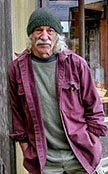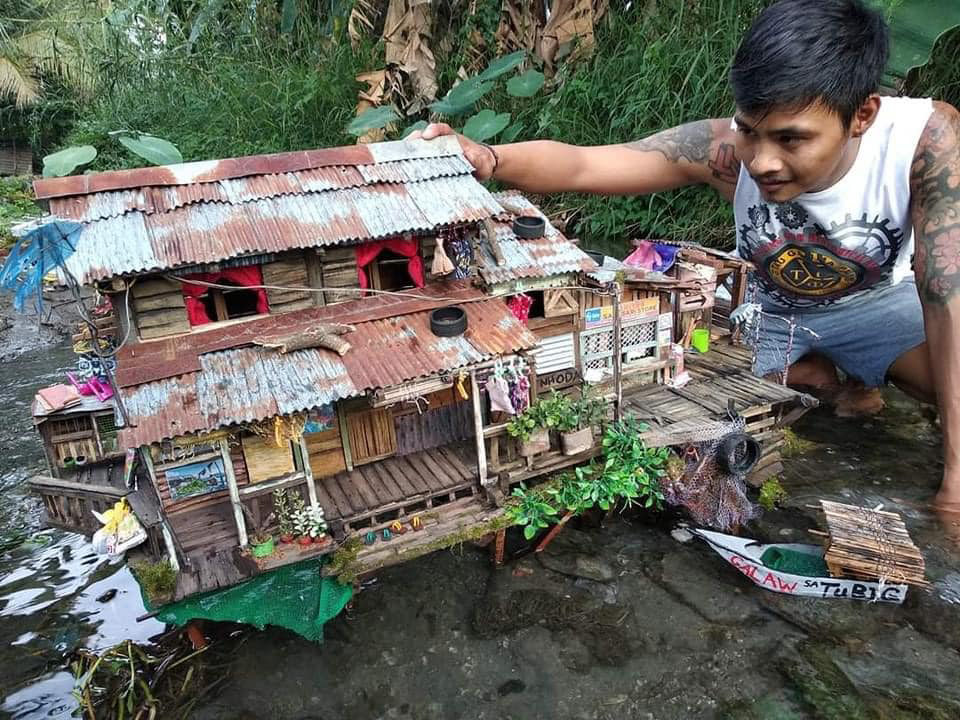So Hello Lloyd. Here is my last creation. A gazebo? An arbor? A little barn? A playground? (I don’t know the name in English for a small timber frame like this!)
It’s a timber frame type king post truss and hammer arch truss — mixed! I made it by cutting the trees, and then using a portable Woodmizer sawmill. I used only chestnut trees because they are so easy to work with — it’s my favorite wood.
For making the curved pieces, I sawed two sides with the sawmill, then the curved faces with a beautiful old 1947 Guillet bandsaw. Next, I drew the axis of my frame with a chalkline and defined the top and the visual sides. Then I traced the axis and levels of my frame on the floor of the workshop with a chalkline, pencil and colored chalk. I placed the pieces on the lines and with a carpenter’s plumb bob (flat and empty in the middle), I drew the assemblages — this is called piquage.
When all the wood was traced, I machined and cut the pieces — the tenons with circular and hand saws, drill, and chisels, and my mortises with a special mortise-machine. Then I made a mise à blanc (dry run), then the finishing touches, the sculptures. I planed the wood’s edges with a draw knife and used lime and water to create a beautiful brown old-style color.
Now to erect it! For the heaviest beams, we used a long aluminum ladder with a system of four pulleys and rope.
This structure is in “Layotte,” a high-quality restaurant in southwest France, where I made two other structures in the same style. The first one 18 years ago with a twisted roof — 12 meters long, 2.5 meters on one side and 5 meters on the other, so the roof is totally curvy! The table too has a trapezoidal shape, that makes a strange vision! You are welcome to eat in my country!
Advanced Search (single or combined)
Archives
Recent Posts
- I’m Switching My Blog to Substack May 18, 2024
- Tiny Home on Wheels and Chinese Van April 17, 2024
- Scotty and Marissa’s Travels in Latin America March 19, 2024
- Building a DIY Cabin with Friends, from Start to Finish March 12, 2024
- Keith Richards and Crew Doing Lou Reed’s “I’m Waiting for the Man” March 4, 2024
- Gary’s Van Home February 28, 2024
- Adventures with Chilón February 27, 2024
- Reflections on Trip to Baja February 26, 2024
- Monster Gringo Houses on East Cape February 23, 2024
- Perfectly Proportioned Building at La Fortuna February 22, 2024
- Palapa over Trailer February 21, 2024
- Crashed Cocaine Plane February 20, 2024
- Panga Beach Landing February 19, 2024
- Running Shoe Sandals February 18, 2024
- Angel Robles from Oaxaca and His Huichol Beadwork February 17, 2024
- Carvestyle Longboard Surfing Somewhere in Baja February 16, 2024
- Taco Power in Ciudad Constitución February 15, 2024
- César’s Birthday Party Under the Trees in El Triunfo February 14, 2024
- Japanese Cyclist Out in Middle of Nowhere on a 7-year-old American Steel Bike February 13, 2024
- What Baja Sur Was Like 67 Years Ago February 11, 2024
- Ready for the Road, Two Weeks Ago February 10, 2024
- GIMME SHELTER – February, 2024 February 8, 2024
- Houses in Sunset District, San Francisco January 27, 2024
- Yogan’s New Tower in France January 26, 2024
- LK Interview December 2023 January 18, 2024
Recent Comments
- Ocean on Houseboat For Sale in BC Canada
- Glenn Storek on Obituary for Robert C. Kahn
- Thomas Rondeau on My Home in Big Sur, Built in the ’60s
- Thomas Rondeau on My Home in Big Sur, Built in the ’60s
- Anna Gade on I’m Switching My Blog to Substack
- Mr. Sharkey on I’m Switching My Blog to Substack
- Chris on Scotty and Marissa’s Travels in Latin America
- Jeff on Keith Richards and Crew Doing Lou Reed’s “I’m Waiting for the Man”
- Pauline liste on RIP Lloyd House
- stephane chollet on RIP Lloyd House
- Robert Hayes-McCoy on Old Thatched Cottage in Ireland
- Bonnie Peterson on Val Agnoli’s Sculptural Home
- Geoff Welch on Building a DIY Cabin with Friends, from Start to Finish
- Irene Tukuafu on GIMME SHELTER – February, 2024
- Lloyd Lindley II on The Heddal Stave Church in Norway
- Paul Recupero on ORGANIZED SLIME: The Great Septic Rip-off of the 21st Century






















